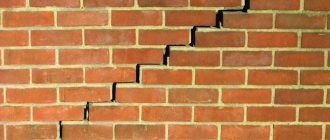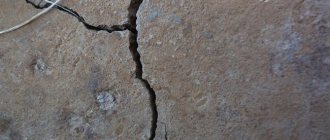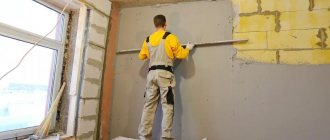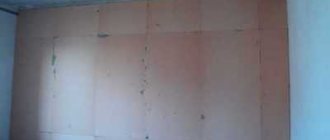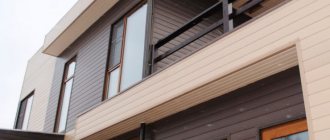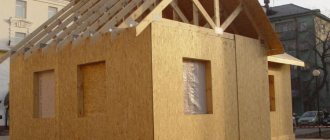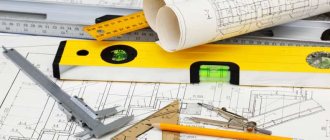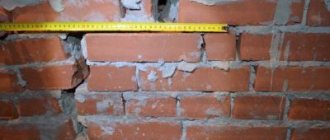There are a huge number of reasons leading to the appearance of cracks in brick houses. This includes unexpected seismic activity, mechanical damage, and errors made during construction. For example, cracks can occur due to incorrect lining of the brickwork of the load-bearing walls of the house. What to do if a crack in the wall of a brick house has already appeared? In any case, the house will need both superficial, cosmetic and thorough repairs to eliminate the causes of damage if they appeared due to violations of construction technology. If you do not strengthen the base and walls of the house in time, then one small gap can provoke a distortion of the supporting structure and irreversible deformation of the house .
There is a crack in the wall of a panel house, what to do? Types of cracks
Open cracks in a panel house
There are two types of cracks in the walls of panel houses: open and closed. The names speak for themselves.
Closed cracks are located inside the walls and are not visible without special equipment. And open ones can be seen with the naked eye.
Any of these types of cracks is most often developing and without a set of measures to eliminate it will only lead to deterioration.
It is also worth paying close attention to the location of the crack in an external or internal wall, in a load-bearing wall or in a partition, possibly on the ceiling or floor.
To independently analyze the risk of developing a split, it is possible to simply install a plaster beacon. If the lighthouse remains intact during the season, it means that there is no crack development and it can be repaired.
At the same time, growing cracks will show their variability and will constantly increase in volume. Stable cracks are the most favorable when considering this problem.
In addition, there are technological gaps that appear during the drying of components used in finishing and construction.
To avoid this type of crevices, various fastening materials resembling meshes are usually used. These cracks will not lead to the destruction of structures, but will only change its aesthetics.
If you try as hard as possible to distribute the cracks in the walls into subgroups, you will get the following picture:
- For reasons: additive, deformation, temperature, structural, and also resulting from wear or weathering of walls.
- By destruction: cuts, crushing and ruptures.
- In direction: oblique, vertical and horizontal direction.
- In shape: curvilinear, straight and closed (not touching the edges of the walls) contour.
- By depth: external and through crevices.
- By risk level: safe and dangerous.
- By time: stable-permanent and unstable-permanent fractures.
- By opening: large, small, hairy, developed.
Causes
In new multi-apartment buildings, problems with the quality of walls periodically arise. Faults and cracks appear in the ceiling and other places. Reasons why cracks appear in the house:
- the structure was poorly constructed;
- the soil has settled poorly;
- heavy load on the foundation of the building;
- frequent flooding with liquid from neighbors, leaking house;
- the soil has changed since the house was built;
- the wall is drying out;
- winter and cold, freezing of structures, poor-quality heating system.
Small cracks in the walls cannot be ignored. It is much easier and cheaper to eliminate them while they are small. As the size increases, it becomes more difficult to correct the problem.
What causes cracks in the walls of a panel house?
If the walls were built in compliance with the technology and the operating rules were not violated, then the possible reasons for the formation of cracks are the following:
- Depreciation is the wear and tear of material. End of service life. For example, concrete will last 80-150 years.
- Erosion, weathering. Much faster, the natural environment leads to weakening and is a catalyst.
- The action of the soil itself and groundwater. Quite a common reason. In addition, foundations washed away by groundwater and cyclic freezing of the soil pose a danger.
- Humidity and temperature fluctuations are the most negative factor. Freeze-thaw cycles widen the crack even when the walls are quite resistant to this process.
Danger of a crack in the wall, identification of risks
Having determined the causes of cracking, you can roughly determine the degree of danger of their presence in the wall.
For an objective assessment, you will have to examine the cracks from your neighbors’ apartments and carefully look to see if there have been any redevelopments there. If the relationship is good, the neighbors will show you without any problems, otherwise you will have to collect a commission.
For the most part, the cracks described are harmless. In new buildings, during the first 5 years, while the house “settles”, this is a fairly normal phenomenon, natural shrinkage.
The degree of danger of cracks in the wall
But perestroika or major reconstruction is already dangerous. The degree of danger is usually determined as follows: climbers place plaster notes or strips of special paper.
Required tools and materials
To seal cracks you will need the following material:
- wood glue in the consistency of thin sour cream, mixed with tooth powder or chalk chips;
- strips of cotton fabric, gauze, medical bandage, soaked in PVA glue (they can be replaced with fiberglass tape);
- cement mortar mixed with paint prevents moisture penetration;
- lime-cement mortar reinforced with mesh;
- sandpaper for grouting;
- primer;
- sealant;
- putty mixture;
- polyurethane foam;
- plaster for finishing.
- brush;
- brush;
- putty knife;
- construction mixer;
- foam sponge;
- gun for sealant and polyurethane foam.
In some cases, the work will additionally require a hammer, chisel and a hammer drill with attachments.
How to repair cracks in walls yourself?
If there is a problem - a crack in the wall of a panel house, and there is no idea what to do, first you should decide on its type.
If the size of the crack is insignificant, the easiest way is to eliminate it with foam, followed by plaster and putty. But you should not fill large cracks with construction foam or other components, as this will accelerate crushing.
Through cracks are the most dangerous and their rather sensitive expansion will lead to the fall of the floor slabs. This solution can only be a temporary solution to survive the winter, during which it is irrational to do major repairs.
In addition, professionals in many cases recommend using gypsum mixtures; they are easy to find these days. The repair technology is quite simple. How to cover cracks in an apartment wall? The crack “opens up”, is cleared of dust and dirt, the surface is washed with water and dries.
After reading the instructions, mix it with water, stir until smooth without any clots and seal the crack.
Apply the solution using a spatula. Do not forget that gypsum tends to expand, so you need to make sure that there is a sufficient amount of solution in the cracks.
If you do not take this point into account, there will be more gypsum than necessary, the crack will worsen, and a new displacement of the wall will arise.
Once the removal is complete, you need to let the plaster dry completely, this is about 5-6 hours. Then use sandpaper to clean off any remaining plaster. And admire the updated smooth wall.
You can also make a good old 3 to 1 mortar, parts sand to parts cement, adding water. This solution will be most suitable for uniformity to the panel wall.
It is applied in the same way as gypsum mortar, using a spatula. When dry, it has less impact on the wall, but here you need to understand a little about the properties of sand, it should not be greasy.
It is also recommended to apply a mesh on the outer surfaces of the crack. It will stop the appearance of small cracks when the solution dries. It will create a so-called skeleton for structural strength.
To stop the development of large cracks, you can install a channel (anchor) or metal plates. To do this, the wall is cleared of plaster, approximately 50 cm in each direction from the edge of the crack, and plates are installed.
Methods for replacing a base that has become unusable
If after diagnostic checks you realize that the subwall cannot be restored, it will need to be replaced. To carry out a complete replacement, it is necessary to unload the old foundation so that not a single wall of the building is damaged.
To preserve the integrity of houses, the following is used:
- Installation of supports, the fixation of which is carried out perpendicular to the old foundation;
- Installation of stone pillars on which the walls of the building are placed;
- A system of braces that transfers the load from the house to the soil.
If the foundation is being deepened, the walls of the building must be strengthened with struts. After strengthening with struts, a dig is made under the base. The walls of the dug trench are reinforced with formwork. The old sole is cleaned of dirt and concrete. Afterwards, a hard cement mortar enriched with fine crushed stone is poured.
Who should pay for cracks in the walls of a panel house?
Crack in the wall of an apartment building - where to contact
First, you need to decide on the situation and find the real root cause. These may be the builders themselves, also developers, neighbors or third parties.
To do this, you need to contact a management company or homeowners association, which first draws up a deed, installs beacons and monitors their position.
And then follow the procedure described earlier. If the situation is complicated, with a fairly large crack, when the management company and the HOA do not take any action, it is worth filing an application with the City Housing Inspectorate and waiting for the commission to appear.
But it is worth remembering that since 2010, the Supreme Arbitration Court of the Russian Federation has issued a resolution, the essence of which is that this issue is completely assigned to the management company.
And then she deals with the search for the root cause and the culprits, if any. The commission, which must include an engineer from the BTI, must reflect in the act everything that is said regarding the cracks in question, objectively. It is also advisable to have neighbors as witnesses.
Then the housing office must do something concrete. They should have a specific deadline of 2-4 weeks to make a decision. And after this period, you can prepare a letter to the local administration. Then ask the administration for an independent construction assessment. Here you need to be persistent and not let go of the situation.
Remember what they will tell you: cracking in panel houses is a common occurrence, and you don’t have to do anything. So globally, there is no reason to worry.
Instead of letting the situation go, this is: first a complaint is written, a week or two later a call is made to clarify the current state of affairs. When the period for consideration of a complaint by law expires, immediately contact above.
And then things will really get going. It is also good if there is an open website for complaints to the regional or territorial administration (addressed to the governor).
Cracks in the walls of the house, how to avoid it:
See also Telephone numbers for consultation May 13, 2022 kasjanenko 986
Share this post
Discussion: 3 comments
- Natalya says:
06/28/2018 at 13:58We moved into a new building and the mother-in-law left after about six months. The developers turned out to be at fault and they carried out complete renovations. But it’s fortunate that the reason was not serious and did not threaten the complete destruction of the building. Since many residents had nowhere to move, we would simply be left without housing.
Answer
- Ivan says:
03/05/2019 at 15:33
The appearance of a crack in an external wall or in a load-bearing partition is a sign of design flaws that no repair can completely eliminate. In this case, is it possible to require the developer to provide housing in another building?
Answer
- Ivan says:
01/24/2020 at 01:00
If such cracks appeared as a result of the installation of new double-glazed windows by one of the residents, can other residents require him to repair these cracks at his own expense?
Answer
Where to contact
If cracks are detected, contact the management company. If the organization does not want to carry out and pay for repairs, it is necessary to go to the administration of the management company. In any case, the answer will come in writing. If the complaint is not considered there, you can call higher services:
- to the department of construction in the city;
- to the official housing inspection;
- to the prosecutor's office;
- to the judiciary;
- to Rospotrebnadzor.
Filing an application to the judicial authorities is the last step. To resolve the problem, the client must file a lawsuit against the companies that refused to restore and repair cracks in the walls. According to the law, complaints can be filed with a variety of organizations at once.
An inspection report must be attached to the complaint. If it was not carried out due to the refusal of the management company, you have the right to call an employee from special organizations.
ATTENTION! It is also necessary to provide photographs showing how the walls are cracking or documents of refusal of management companies.
